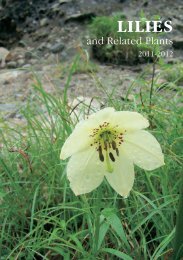LILIES - RHS Lily Group
LILIES - RHS Lily Group
LILIES - RHS Lily Group
You also want an ePaper? Increase the reach of your titles
YUMPU automatically turns print PDFs into web optimized ePapers that Google loves.
Left, Erythronium multiscapoideum forms large colonies by producing stolons, here<br />
in Magalia, Butte Co., California and has a ‘many-scaped’ appearance (inset).<br />
Above left, E. oreganum is slow to increase vegetatively but is probably the finest<br />
of the white-flowered species, here in Douglas Co., Oregon; above right, E. helenae<br />
– the large yellow zone in the centre of the flowers, the yellow anthers and slender<br />
filaments help to distinguish this from other white-flowered species.<br />
the UK, requiring the generally cooler conditions to be found in the north. These<br />
two factors – aesthetics and ease of cultivation – are important in the overall<br />
assessment for an AGM. So, even before the trial it was predictable which ones<br />
might be eligible.<br />
Western North-American species<br />
One of course stands out and that is the clone of E. californicum known as ‘White<br />
Beauty’. This is undoubtedly beautiful, grows with enthusiasm given slight shade<br />
and a deep, humus-enriched soil and, very importantly, increases vegetatively at a<br />
reasonable pace by producing offsets. It is this last characteristic that perhaps calls<br />
into question its attribution to E. californicum as plants grown from wild collected<br />
seeds of this species do not appear to have the same useful character. However, in<br />
all other respects it seems to be well within the range of morphological variation<br />
of this Californian species. It was Carl Purdy who gave one of his selections the<br />
name but whether the clone widely cultivated today is the same as his original<br />
is hard to say. Coloured illustrations from his catalogues of the early twentieth<br />
81




